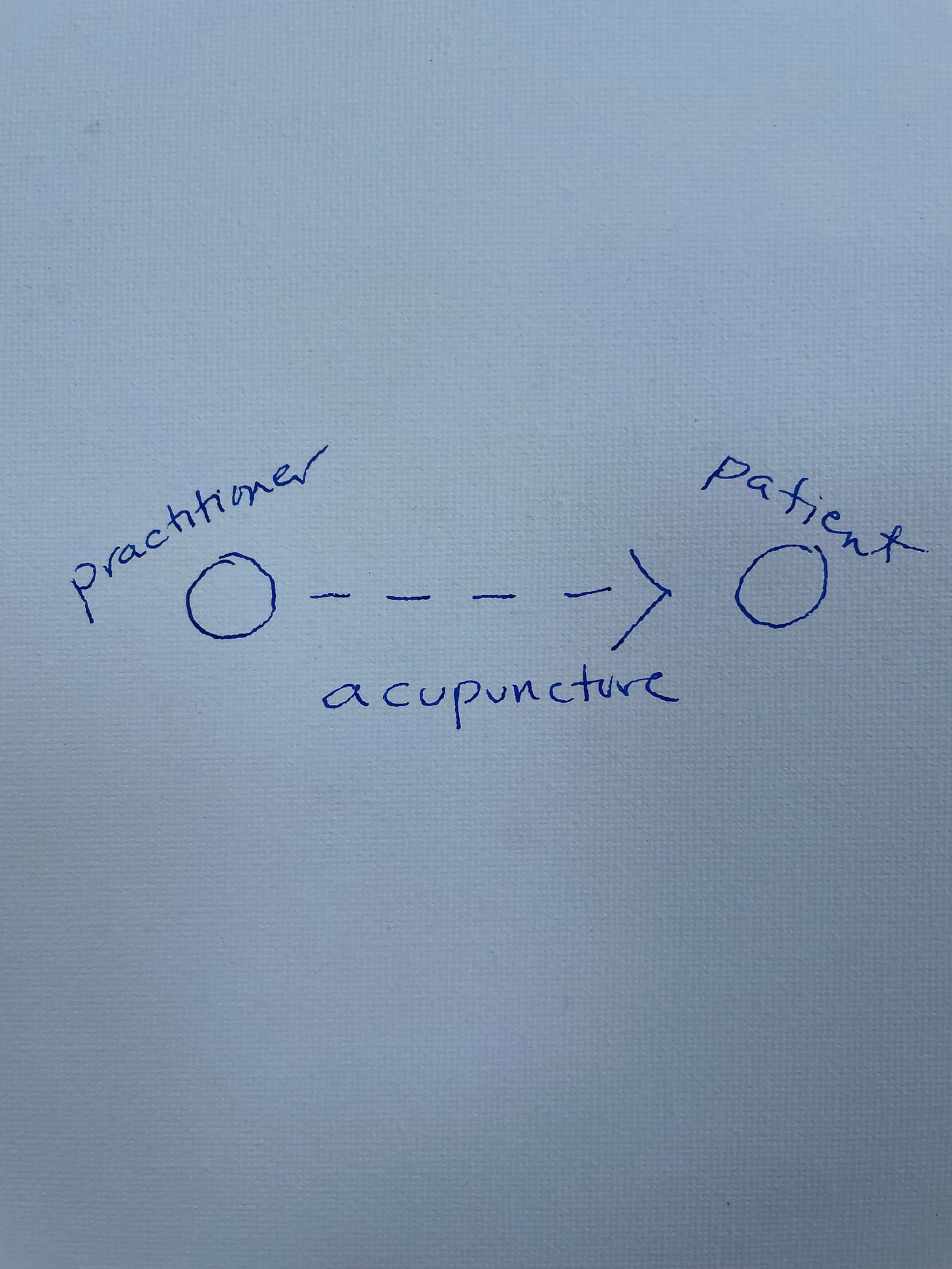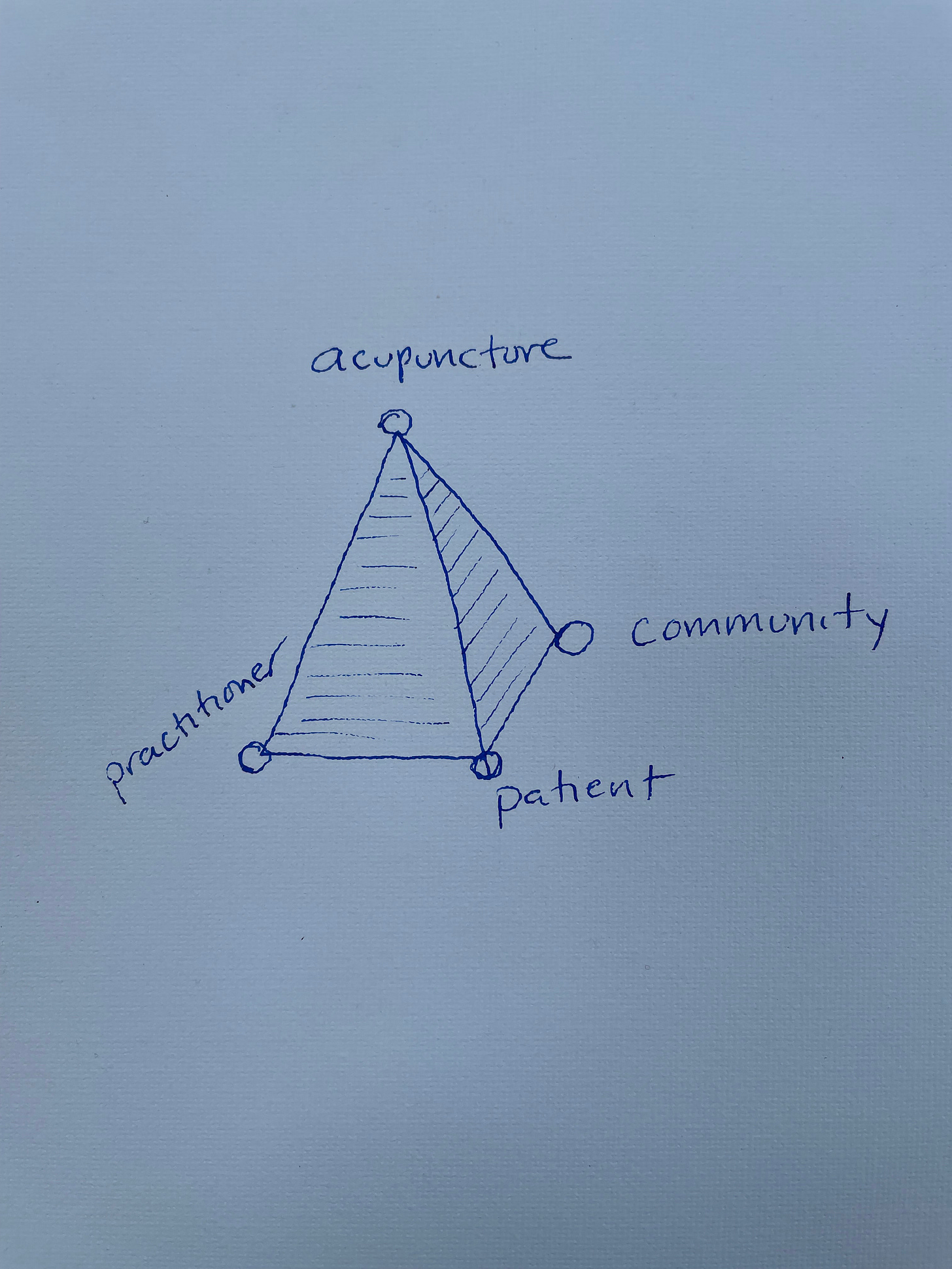As I mentioned last week, I had COVID (I’m mostly recovered now) and so my disclaimer for this newsletter is that these thoughts seemed compelling when I was running a fever — so I might just be inflicting my febrile free associations on you. Welcome to the inside of my head! It’s a weird place even without COVID!
Awhile back I was on a podcast where the host semi-jokingly described me as a heretic. One of Merriam-Webster’s definitions of heresy is “dissent or deviation from a dominant theory, opinion, or practice” so okay, guilty as charged. For some reason I remembered that while I was sick and it somehow led to geometry. (Please pardon my goofy drawings and possible typos.)
I was thinking about teaching community acupuncture and the possible heresies involved with that exercise, and it occurred to me that probably the most important thing I didn’t know about acupuncture back in 1994 when I got my license that I know now, is how collaborative a successful acupuncture practice is — how much being a good clinician overlaps with being a good collaborator.
What I learned in school was that the elements of an acupuncture practice were supposed to be arranged like this, in a sort of two-dimensional line:
where acupuncture is something the practitioner gives to the patient, or does to the patient, or something like that. For the acupuncturist, that mindset leads to prioritizing questions like: am I doing this right? Should I maybe be doing something else to patients like giving them massage or nutritional counseling? Can I call myself a doctor while I’m doing this? And the whole linear arrangement is designed to fit neatly into an ICD-10 code for insurance billing.
What I learned by doing a lot of acupuncture treatments in a lot of different settings over a bunch of years, though, was that my practice wasn’t so neat and linear, and actually it made more sense if I expanded it into a triangle, like this:
Which is where the heresy begins. My experience was that acupuncture isn’t something that I do or give in tidy billable increments, it’s something I have a relationship with, and my patients also have a relationship with it that might be very different from mine. A major part of my job is to facilitate my patients’ relationship with acupuncture. Treatment is a collaboration.
Also, acupuncture does what it pleases -- it’s not under my control.
One thing I learned pretty early in my practice is that treating people who are recovering from surgery is very satisfying -- because if people can get frequent acupuncture after surgery, their healing process speeds up. (This is also true for broken bones). I got pleasantly accustomed to the part where a patient would come into clinic and report, “My surgeon was amazed! I’m way ahead of schedule! They said, I don’t know what you’re doing but whatever it is, don’t stop!” I had one patient who had major abdominal surgery, who was considered frail, whose visiting nurse declared was healing twice as fast as she was supposed to be. She was getting acupuncture every day.
Did I figure out some amazing technique to create these results? Nope. I did pretty much the same basic treatments I’d be doing if my patients hadn’t just had surgery. Acupuncture did its thing and I observed it. A key element, though, was how my patients who got great results established their own relationship with acupuncture. They knew how it made them feel, they knew what it did for them, they had their own habits and rituals around receiving it. I could facilitate that relationship, but I wasn’t in charge of it. To get enough acupuncture to get great results, they had to like it -- as much or more than they liked me.
And from doing a lot of informal coaching of other acupuncturists over the years, I learned that if someone’s struggling with their practice, it helps to distinguish which part of the triangle is the problem. An acupuncturist might do a fine job delivering acupuncture treatments, but a lousy job at facilitating their patients’ relationship with acupuncture, or maybe they’re just not good with people in general (the base of the triangle). Which means they could work on their acupuncture techniques and strategies all day long but their practice as a whole won’t grow, because their relationship with acupuncture isn’t the problem. Conversely, an acupuncturist might be great with people but they don’t actually trust acupuncture itself (the left side of the triangle).
But I think what the heresy is really about is what happens when you add community as a fourth element:
Boom! We’ve popped out of two dimensions into three and it’s a whole different world! It’s a tetrahedron, it has weight and depth and volume! I love this, it’s my favorite thing, but I get that it isn’t everyone’s. If you really like the neatness of the two dimensional line, a tetrahedron is just weird.
If you can’t believe that patients build relationships with acupuncture itself apart from their relationship with a practitioner, it’s going to be hard to swallow that a whole community could have a relationship with acupuncture. And granted, some patients don’t want that either -- acupuncture for them is about their individual relationship with a doctor-figure, that’s what they like about it and that’s fine, people are different! But what I learned in my practice was that many, many patients will form their own meaningful relationships with acupuncture (and many of them won’t fit the wealthy-white-lady-luxury stereotype AT ALL) -- but you have to consciously give them the opportunity. It takes time and infrastructure to properly offer it, to make acupuncture something that a community can use. Relationships don’t happen overnight.
Here’s an example involving WCA: last year, a Portland journalist wrote a humorous column about eight things she’d rather spend $20 a month on than a Twitter verification — and one of those things was community acupuncture. In a list of pleasures that included ice cream and books and moisturizer, she linked to WCA, “where you sit in a calm, dark room with other people and feel good afterward.” I’m sure that column made some acupuncturists cranky — there goes WCA devaluing the acupuncture profession AGAIN — and not just because of the $20 but because of a presentation of acupuncture that didn’t include a doctor-figure. Just a calm room, the presence of other people, feeling good. That’s what it’s like inside the tetrahedron.
I’ll go even further and say that I think communities should have more opportunities to create relationships with acupuncture that don’t require a doctor-figure to mediate or gatekeep. Community acupuncture can be about acupuncturists collaborating with communities. Stay tuned for more heresy.






